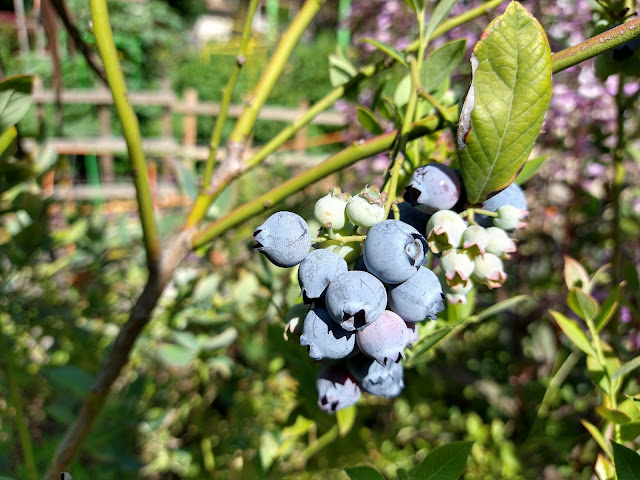
After weekend showers, triple-digit days are coming soon

|
|
Pick blueberries now before heat — or birds — get to them. (Photo: Debbie Arrington)
|
Did you feel a sprinkle? Or maybe measurable precipitation?
June’s first weekend should includ a splash of summer rain with “likely” showers on Sunday, says the
National Weather Service
. Before and after any raindrops, cloudy skies are keeping temperatures comfortably cool. Sacramento’s afternoon highs for both days are forecast in the high 70s.
But things are about to change – again, warns the weather service.
“Enjoy the cooler temperatures this weekend because things are going to heat up next week!” tweeted the NWS Sacramento office. “Widespread triple digits in the Valley are expected by Friday.”
How hot? Right now, the NWS is predicting 105 degrees for Sacramento on Friday. By Thursday, nights will be warm, too, staying above 70 degrees – warmer than most of Sunday. Normal for June in Sacramento: Highs of 87 degrees and lows of 56.
What does this mean for your garden? In between drizzle, tackle chores Sunday and Monday before temperatures start to climb.
By Thursday, triple-digit days are possible. Adds the weather service, “Stay hydrated and take extra precautions to prevent heat-related illnesses. Visit
http://weather.gov/safety/heat
to learn more!”
* Keep your garden hydrated, too. Water early in the morning. Cycle and soak to avoid runoff. Deep water trees and shrubs.
* Generally, tomatoes need deep watering two to three times a week, but don't let them dry out completely. That can encourage blossom-end rot.
* Let the grass grow longer. Set the mower blades high to reduce stress on your lawn during summer heat.
* Mulch, mulch, mulch! This “blanket” keeps moisture in the soil longer and helps your plants cope during hot weather.
* Avoid pot “hot feet.” Place a 1-inch-thick board under container plants sitting on pavement. This little cushion helps insulate them from radiated heat.
* Tie up vines and stake tall plants such as gladiolus and lilies. That gives their heavy flowers some support.
* Dig and divide crowded bulbs after the tops have died down.
* Feed summer flowers with a slow-release fertilizer. Always water before adding fertlizer.
* Thin grapes on the vine for bigger, better clusters later this summer.
* Pick blueberries and strawberries as they ripen — and before those triple-digit days.
* Cut back fruit-bearing canes on berries.
* Cut back Shasta daisies after flowering to encourage a second bloom in the fall.
* Trim off dead flowers from rose bushes to keep them blooming through the summer. Roses also benefit from deep watering and feeding now. A top dressing of aged compost will keep them happy. It feeds as well as keeps roots moist.
* Pinch back chrysanthemums for bushier plants with many more flowers in September.
* From seed, plant basil, corn, melons, pumpkins, radishes, squash and sunflowers.
* Transplant summer annuals such as petunias, marigolds and zinnias.
* Transplant perennial flowers including astilbe, columbine, coneflowers, coreopsis, dahlias, rudbeckia, salvia and verbena.
Comments
0 comments have been posted.Sacramento Digs Gardening to your inbox.
Food in My Back Yard Series
April 22: Should you stock up on fertilizer? (Yes!)
April 15: Grow culinary herbs in containers
April 8: When to plant summer vegetables
April 1: Don't be fooled by these garden myths
March 25: Fertilizer tips: How to 'feed' your vegetables for healthy growth
March 18: Time to give vegetable seedlings some more space
March 11: Ways to win the fight against weeds
March 4: Potatoes from the garden
Feb. 25: Plant a fruit tree now -- for later
Feb. 18: How to squeeze more food into less space
Feb. 11: When to plant? Consider staggering your transplants
Feb. 4: Starting in seed starting
Sites We Like
Garden Checklist for week of April 27
Once the clouds clear, get to work. Spring growth is in high gear.
* Set out tomato, pepper and eggplant transplants.
* From seed, plant beans, beets, cantaloupes, carrots, corn, cucumbers, melons, pumpkins, radishes and squash. Plant onion sets.
* In the flower garden, plant seeds for asters, cosmos, celosia, marigolds, salvia, sunflowers and zinnias. Transplant petunias, zinnias, geraniums and other summer bloomers.
* Plant perennials and dahlia tubers for summer bloom. Late April is about the last chance to plant summer bulbs, such as gladiolus and tuberous begonias.
* Transplant lettuce and cabbage seedlings.
* Weed, weed, weed! Don’t let unwanted plants go to seed.
* April is the last chance to plant citrus trees such as dwarf orange, lemon and kumquat. These trees also look good in landscaping and provide fresh fruit in winter.
* Feed citrus trees with a low dose of balanced fertilizer (such as 10-10-10) during bloom to help set fruit. Keep an eye out for ants.
* Apply slow-release fertilizer to the lawn.
* Thoroughly clean debris from the bottom of outdoor ponds or fountains.
* Start thinning fruit that's formed on apple and stone fruit trees -- you'll get larger fruit at harvest (and avoid limb breakage) if some is thinned now. The UC recommendation is to thin fruit when it is about 3/4 of an inch in diameter. Peaches and nectarines should be thinned to about 6 inches apart; smaller fruit such as plums and pluots can be about 4 inches apart. Apricots can be left at 3 inches apart. Apples and pears should be thinned to one fruit per cluster of flowers, 6 to 8 inches apart.
* Azaleas and camellias looking a little yellow? If leaves are turning yellow between the veins, give them a boost with chelated iron.
* Trim dead flowers but not leaves from spring-flowering bulbs such as daffodils and tulips. Those leaves gather energy to create next year's flowers. Also, give the bulbs a fertilizer boost after bloom.
* Pinch chrysanthemums back to 12 inches for fall flowers. Cut old stems to the ground.
* Mulch around plants to conserve moisture and control weeds.